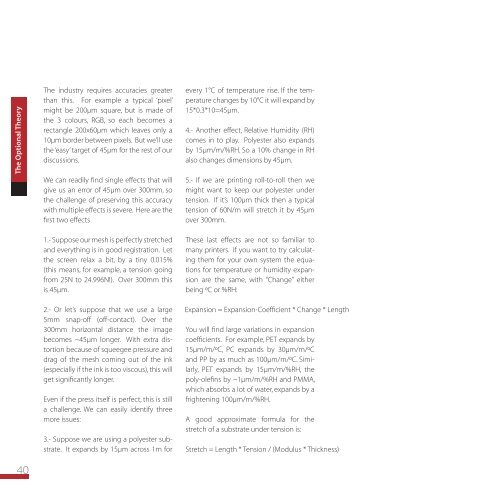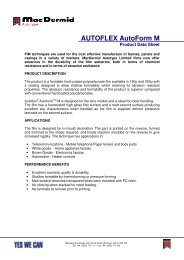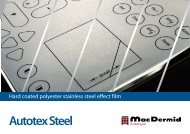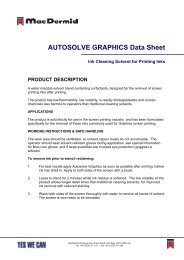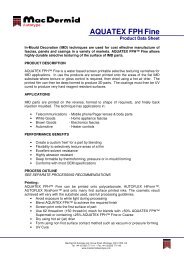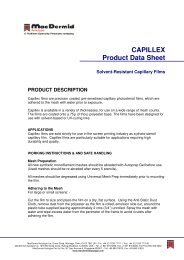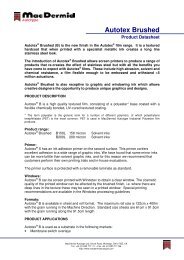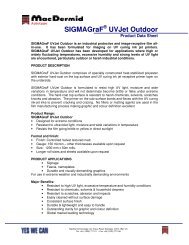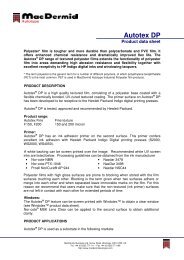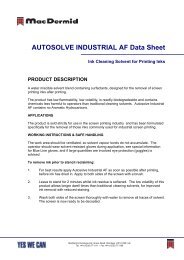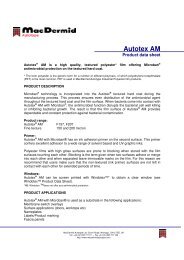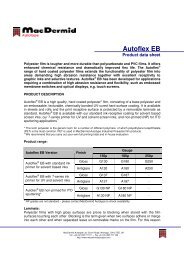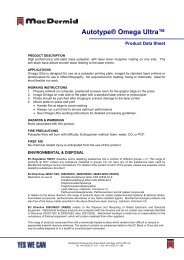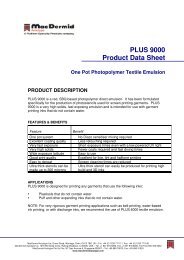Screen E-Book (.PDF) - MacDermid Autotype
Screen E-Book (.PDF) - MacDermid Autotype
Screen E-Book (.PDF) - MacDermid Autotype
- No tags were found...
You also want an ePaper? Increase the reach of your titles
YUMPU automatically turns print PDFs into web optimized ePapers that Google loves.
The Optional Theory40The industry requires accuracies greaterthan this. For example a typical ‘pixel’might be 200µm square, but is made ofthe 3 colours, RGB, so each becomes arectangle 200x60µm which leaves only a10µm border between pixels. But we’ll usethe ‘easy’ target of 45µm for the rest of ourdiscussions.We can readily find single effects that willgive us an error of 45µm over 300mm, sothe challenge of preserving this accuracywith multiple effects is severe. Here are thefirst two effects1.- Suppose our mesh is perfectly stretchedand everything is in good registration. Letthe screen relax a bit, by a tiny 0.015%(this means, for example, a tension goingfrom 25N to 24.996N!). Over 300mm thisis 45µm.2.- Or let’s suppose that we use a large5mm snap-off (off-contact). Over the300mm horizontal distance the imagebecomes ~45µm longer. With extra distortionbecause of squeegee pressure anddrag of the mesh coming out of the ink(especially if the ink is too viscous), this willget significantly longer.Even if the press itself is perfect, this is stilla challenge. We can easily identify threemore issues:3.- Suppose we are using a polyester substrate.It expands by 15µm across 1m forevery 1°C of temperature rise. If the temperaturechanges by 10°C it will expand by15*0.3*10=45µm.4.- Another effect, Relative Humidity (RH)comes in to play. Polyester also expandsby 15µm/m/%RH. So a 10% change in RHalso changes dimensions by 45µm.5.- If we are printing roll-to-roll then wemight want to keep our polyester undertension. If it’s 100µm thick then a typicaltension of 60N/m will stretch it by 45µmover 300mm.These last effects are not so familiar tomany printers. If you want to try calculatingthem for your own system the equationsfor temperature or humidity expansionare the same, with “Change” eitherbeing ºC or %RH:Expansion = Expansion-Coefficient * Change * LengthYou will find large variations in expansioncoefficients. For example, PET expands by15µm/m/ºC, PC expands by 30µm/m/ºCand PP by as much as 100µm/m/ºC. Similarly,PET expands by 15µm/m/%RH, thepoly-olefins by ~1µm/m/%RH and PMMA,which absorbs a lot of water, expands by afrightening 100µm/m/%RH.A good approximate formula for thestretch of a substrate under tension is:Stretch = Length * Tension / (Modulus * Thickness)


